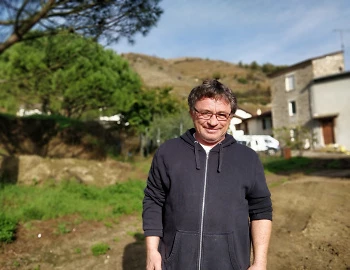Le Grand Blanc 2021
Vin de France, Maison Stéphan, 750 ml

Description
The blend of Roussane, Marsanne and Viognier comes from the three municipalities of Ampuis, Condrieu, Roussillon, grown on different soil formations such as biotite granite, glacial moraine and old alluvial soils of the Rhône. The Grand Blanc unfolds a bouquet reminiscent of ripe mirabelles, almond-marzipan croissants, vanilla and pear-apple jam. It covers the palate with a silky-creamy texture, has a warming, mouth-filling character and reveals aromas similar to those in the bouquet. We recommend decanting the wine or opening it a few hours before drinking.
Attributes
| Grape variety: | Roussanne, Marsanne, Viognier |
| Producer: | Maison Stéphan |
| Origin: | France |
| Label: | Certified organic or biodynamic wine |
| Ripening potential: | 2 to 6 years |
| Drinking temperature: | 10 to 12 °C |
| Food Pairing: | Fish ragout with saffron sauce, Roast veal with morel sauce, Cheese board, Salad with vegetables, pulses, pasta |
| Vinification: | fermentation at low temperatures |
| Maturation: | partly in concrete tank, partly in steel tank |
| Maturation duration: | 8 months |
| Volume: | 12.5 % |
| Note: | Contains sulphites |
Maison Stéphan
Jean-Michel Stéphan has vinified more than 30 vintages of Côte-Rôtie and is one of the true masters of natural winemaking (vins naturels) in the northern Rhône region. His wines have a vibrant purity that makes them unmistakable, characterised by a balance of energy and transcendence that stems from his vision of making impeccable wines without any additives.

Roussanne
The vivacious redhead
“Roux” is French for “rust-red” or “red-haired”, just the way the ripe berries of Roussanne gleam. The grape thrives in the northern Rhône Valley, where it shapes, among others, the white wines of Hermitage, Crozes-Hermitage and Saint-Joseph. Further south, it contributes its lively acidity and aromatic bouquet of apricot, herbs and flowers to white Châteauneuf-du-Pape and Côtes du Rhône. It is almost inextricably linked with its close relative the Marsanne, with which it is nearly always blended. As early as 1781 they were both mentioned together in a text about the Hermitage region. For the last few years, they have even celebrated successes in California. A group of vintners there, nicknamed the “Rhône Rangers” – an allusion to the hero from Westerns – cultivates typical Rhone varieties.

Viognier
Saved from extinction
It’s hard to believe that the Viognier nearly became extinct 50 years ago. Today, it grows worldwide on over 10,000 hectares. The variety was first mentioned in 1781, and probably originated in Condrieu, in the northern Rhône Valley. There, and in the 3.8-hectare mini-appellation of Château-Grillet, vintners kept it on the post when the rest of the world wanted to know nothing about it. Its inventory shrank to a meagre 14 hectares. This is because it provides only low yields, and for a while there were no good seedlings. In the 1980s, interest in Viognier reawakened. It actually shows a unique profile: deep golden with good body and aromas of apricot, lime blossom, citrus fruits, honey and hazelnut. It is popular in the Languedoc region, flows into the white Côtes du Rhône and also does very well in California. The best examples fit wonderfully with poultry in cream sauce, noble fish like turbot or – why not? – lobster.

Marsanne
Better in twos than alone
The Marsanne features a distinctive bouquet of flowers, cherries and marzipan. This white grape probably comes from the area around the village of Mars Anna on the Drôme, a tributary of the Rhône. Today, their stronghold is in the northern Rhône Valley, in the fields of Hermitage, Crozes-Hermitage and Saint-Joseph. Wherever Marsanne grows, Roussanne is not far away. Both grapes are closely related. They are even mentioned together in a document from 1781. They complement each other perfectly: the low-acidity Marsanne brings its original flavours, while the Roussanne contributes liveliness. Further south, together they shape the white Côtes du Rhône. However, Marsanne cannot be incorporated into the white specimens of the Châteauneuf-du-Pape. The reason is simple: when grape varieties were being determined in the 1930s, it was not yet known there. It has been cultivated in Australia since the 1860s. In Switzerland, it is known as Ermitage. Here it yields dry and sweet wines with enormous storage ability.

France
France – Philosophy in a bottle
According to French philosophy, wine should be an expression of the soil and climate. They use the word “terroir” to describe this. Terroir makes every wine different, and many especially good. French wine is regarded worldwide as an expression of cultural perfection. The French believe that humans are responsible for the quality of the berries, the vine variety for their character, and nature for the quantity. This philosophy can be expressed succinctly as: “the truth is the vineyard, not the man.”



